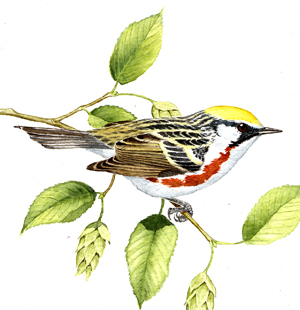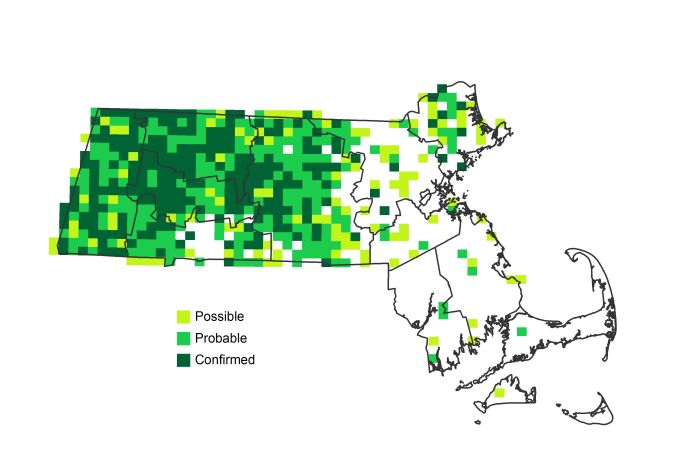Breeding Bird Atlases (BBA)
Find a Bird
Chestnut-sided Warbler
Dendroica pensylvanica

Widespread and likely declining
Action/monitoring needed
“One winter morning the President electrified his nervous Cabinet by bursting into a meeting with, ‘Gentlemen, do you know what has happened this morning?’ They waited with bated breath as he announced, ‘Just now I saw a Chestnut-sided Warbler and this is only February.’” – Corinne Roosevelt Robinson (on her brother Theodore Roosevelt)
Ages ago, when Massachusetts was mostly covered with forest and Europeans had yet to settle the region, the Chestnut-sided Warbler was probably a rare breeder in what is now the Bay State. Forest fire burns, clearings formed by fallen trees, beaver meadows, and sites of frequent flooding were likely the most common natural disturbances prior to European colonization that could maintain the scrubby plant communities that Chestnut-sided Warblers like to exploit. The post-Columbian wide-scale clearing of forests for agricultural fields (and the subsequent abandonment of those fields) opened up swaths of new territory for Chestnut-sided Warblers. By the early twentieth century, this species was abundant statewide. Of course, by the time of Atlas 1, a familiar tale of succession was beginning to play itself out yet again.
Historic Status
The Chestnut-sided Warbler was unfamiliar to John James Audubon, Alexander Wilson, and Thomas Nuttall. After 1800, however, with heavy clearing of primeval forests for agriculture, the population of this handsome warbler grew quickly in the state (Howe & Allen 1901). The species especially thrived when agricultural fields and pastures were abandoned and began to revert to forest. But as the state continued on the path to reforestation in the twentieth century, and few new shrublands were created, the Chestnut-sided Warbler began turning from “one of the commonest of eastern warblers” (Forbush 1929) into a decidedly declining species.
Atlas 1 Distribution
During Atlas 1, the Chestnut-sided Warbler could be found wherever there were fairly open young forests, and occupied 54% of the blocks surveyed. The western regions, especially the Berkshire Highlands, Lower Berkshire Hills, and Marble Valleys, had Chestnut-sided Warblers in more than 90% of their blocks, and most regions west of the Coastal Plains posted over 80% block occupancy. The break in the bird’s western distribution along the Connecticut River Valley illustrates that Chestnut-sided Warblers are more a bird of young forests than of old fields. Accordingly, the forests of the Worcester Plateau and the Lower Worcester Plateau both had notable concentrations. The central and northeastern parts of the Coastal Plains were also hot spots for the Chestnut-sided Warbler, though the Boston Basin had only a handful of breeding records. The Bristol/Narragansett Lowlands had 27% block occupancy, and the warblers were present but very thinly distributed on the Cape and Islands.
Atlas 2 Distribution and Change
The Chestnut-sided Warbler sings a song that is confusingly similar to some variations of the Yellow Warbler’s song, and sometimes even in the same habitats. As Yellow Warblers waxed in abundance, though, Chestnut-sided Warblers waned. Overall block totals in Atlas 2 are higher than Atlas 1, but the percent of occupied blocks is the same, 54%. In the western highlands, Chestnut-sided Warblers were highly persistent and in some cases even increased their distribution. They also gained ground in the Connecticut River Valley as more young forest habitat became available, but the numbers from the Worcester Plateau regions merely showed small fluctuations. The Coastal Plains were patchily occupied and posted an overall decline in distribution for this species. This species sustained notable losses from the southeastern regions of the state, where disappearances far outstripped meager gains in its footprint, and this contributed to a loss in the species’ effort-controlled statewide footprint.
Atlas 1 Map

Atlas 2 Map

Atlas Change Map

Ecoregion Data
Atlas 1 | Atlas 2 | Change | ||||||
Ecoregion | # Blocks | % Blocks | % of Range | # Blocks | % Blocks | % of Range | Change in # Blocks | Change in % Blocks |
Taconic Mountains | 14 | 87.5 | 2.7 | 24 | 96.0 | 4.3 | 2 | 13.3 |
Marble Valleys/Housatonic Valley | 38 | 97.4 | 7.3 | 39 | 100.0 | 7.0 | 1 | 2.6 |
Berkshire Highlands | 54 | 98.2 | 10.4 | 55 | 100.0 | 9.9 | 0 | 0.0 |
Lower Berkshire Hills | 27 | 96.4 | 5.2 | 30 | 96.8 | 5.4 | 0 | 0.0 |
Vermont Piedmont | 15 | 88.2 | 2.9 | 17 | 100.0 | 3.1 | 1 | 8.3 |
Berkshire Transition | 34 | 89.5 | 6.5 | 40 | 100.0 | 7.2 | 2 | 6.5 |
Connecticut River Valley | 31 | 55.4 | 6.0 | 45 | 69.2 | 8.1 | 8 | 16.7 |
Worcester Plateau | 68 | 87.2 | 13.1 | 86 | 97.7 | 15.5 | 1 | 2.1 |
Lower Worcester Plateau | 60 | 81.1 | 11.5 | 73 | 91.3 | 13.2 | -3 | -5.6 |
S. New England Coastal Plains and Hills | 131 | 48.5 | 25.2 | 124 | 43.8 | 22.3 | -16 | -7.1 |
Boston Basin | 6 | 10.7 | 1.2 | 9 | 16.1 | 1.6 | 3 | 5.5 |
Bristol and Narragansett Lowlands | 29 | 27.4 | 5.6 | 9 | 7.9 | 1.6 | -20 | -19.8 |
Cape Cod and Islands | 13 | 9.6 | 2.5 | 4 | 2.8 | 0.7 | -10 | -8.3 |
Statewide Total | 520 | 53.7 | 100.0 | 555 | 53.5 | 100.0 | -31 | -3.7 |
Notes
The Chestnut-sided Warbler shows significant decreasing Breeding Bird Survey trends in Massachusetts, in the New England/Mid-Atlantic Region, and in the Eastern US overall.



